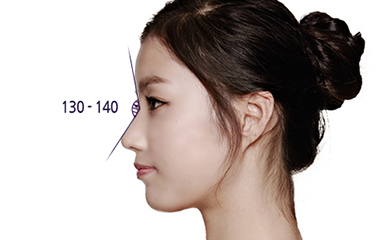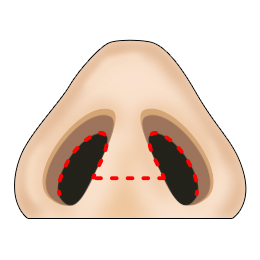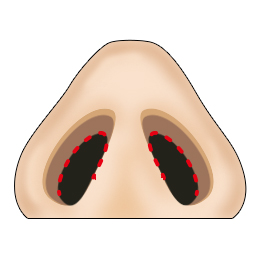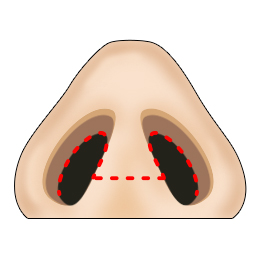- Nose bridge
- HOME > HERSHE Plastic Surgery & Dermatology Nose > Nose bridge

About Rhinoplasty
Augmentation of the nose bridge (nasal dorsum) is referred as rhinoplasty in the medical term; most of cases for rhinoplasty accompany low nasal dorsum with relatively higher nasal tip. Since nose is in the center of face, nose surgery should be planned considering balance with other features of face. Moreover, rhinoplasty should be placed after close diagnosis on each patient’s unique features according to degree of the protrusion of forehead, mouth, lips, and chin. Nose bridge augmentation will improve three-dimensional impression. The ideal angle from the forehead to the nose is considered to be in between 130 degrees and 140 degrees, and implants which are proven for safety is mostly chosen as the material for rhinoplasty rather than autologous cartilage graft. Rhinoplasty should not only consider as nose bridge (nasal dorsum) augmentation, but more fundamental approach needs to be taken to create beautiful nose balanced with other features of the face. Hence, thorough consultation with professional and experienced surgeon should be carried to find the suitable and perfect nose shape. For more natural and satisfying results, nose tip plasty can be done in conjunction with rhinoplasty. |
Ideal ratio of the nose
|
Ideal size of nose is considered as about one third of face length. From the profile, when the angle created by forehead and the nose is in between 130 degree and 140 degree, it is regarded as the ideal angle for the nose. The heart of rhinoplasty is to create beautiful and balanced face considering ideal angle of forehead and nose, and nose and lips. |
Recommended to

Method of Rhinoplasty
Rhinoplasty should be carried by considering proportion of face and balance between its structures. Appropriate length and height of nose should be determined by the balance between facial features. Suitable material and shape of the implant will be chosen based on thickness of skin, proportion of face, size of nose, and desired shape of nose. Type of rhinoplasty surgery methods (open and closed method) will be chosen and operated according to patient’s nose, and implant will be placed under the periosteum. In addition to the rhinoplasty, Nasal tip plasty can also be combined using autologous cartilage graft to create more balanced and beautiful nose shape. Most of swelling will subside in about 7 days to 10 days after the surgery; the final results can be seen 3 months to 6 months after the surgery. |
Open incision method |
VS |
Closed incision method |
||
Incision on inside of nostril and columella of the nose |
Surgery Method |
Incision on inside of the nostril |
|
|
Easy to check inner structure of nose and have wide operation view to be able to insert nose implant in the right position
|
Advantage |
No visible scar since incision will be made inside of nostril |
|
|
incision
line will be made on the external side of nose near columella and it will get
fade away within 3 to 4 months. |
Disadvantage |
Hard to check inside and perform tip plasty due to restricted operation view |
Types of implant for rhinoplasty
Silicone
| Gore-Tex
| Allotherm
| Autoplasty
|
|
1. Gore-Tex can be lowered down over time. 2. Difficult to remove, as it firmly attaches to the tissue. 3. Skin gets thinner after the surgery. |
|
Costal cartilage
Used to prolong the length of the nose or to uplift the height of the nose, as it does not have a curvy character. Fat grafting Rarely have side-effects or irritations, shapes the natural figure. But it is easily absorbable. |
Surgical procedure of Rhinoplasty
|
|
|
|
|
|
01.Choose the right implant and incision point based on the desired nose |
02. Skin tissue will be separated and space for the implant to be inserted will be created |
03. Customized implant will be inserted on the right position and autologous cartilage will be grafted on the nasal tip |
04. Suture incision line delicately |
|


- Consultation: +82 10 3420 4624 Email: hershe.eng@gmail.com
- HERSHE Plastic Surgery, 2~4 floor, 63-12 Cheongdam-dong Gangnam-gu, Seoul, South Korea | Registration number : 211-09-46633|
TEL: 02.546.9526 / FAX: 02.511.9970| Business Name: HERSHE Plastic Surgery | Business Holder: Jung Young Choon



















